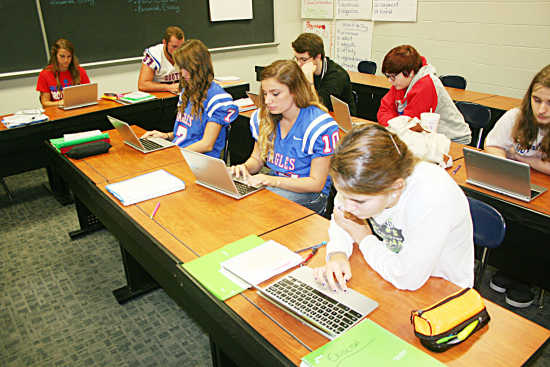Embracing new technology in the classroom

South Putnam's Teacher Tech Team has embraced the change that comes along with evolving educational platforms.
What once was chapter notes scrawled on a chalk board is now a website accessible from anywhere with an Internet connection with almost everything that happened in the classroom during the day. Handwritten homework assignments are also available online or can be found on programs like Google Classroom.
During the course of the last year, Director of Curriculum Instruction and Technology Integration Tona Gardner has led groups of teachers and administrators as the school tries to figure out what is best for the students and is feasible for everyone involved.
The program has been titled "1:1 Together" as the ultimate goal is to put a single device in the hands of each student in the corporation in grades 3 to 12. The title and logo were designed by teacher Brady Rhodes.
During a recent presentation made to the public, Gardner explained devices have been rolled out in some classrooms and programs are being tested. In order to ensure the school prepares students for a digital world, the staff has devoted a lot time and effort to make the right choices.
"Next year, all high school students at South Putnam will have a personal learning device. This personal learning device will be a device they will be using the classroom and they'll also be taking home. The following year, MS and HS will have a personal learning device," Gardner explained.
During the presentation, Gardner addressed the frequently asked question of why the students need to have their own devices to be successful at South Putnam. She explained the teachers have considered three major concepts: The world is different, the students are different and the necessary skills are different. For example, paper job applications, checks, Scantrons and fax machines continue to fall by the wayside.

Chromebooks have been widely used in the classroom in the last few years as South Putnam students and teachers test the best technology for the classroom. The teacher technology team hopes to have computers in the hands of all students grades 3-12, starting with the high school next year.
"Our kids are changing. Not that kids aren't always going to be kids, but their expectations are changing. How they interact with the world -- that's what is changing," Gardner stressed. "They have expectations about how they are going to interact with the world around them. They expect it to be personalized. They expect to be engaged with it. They expect to be able to put their mark on it. It's not unusual for them to be connected with each other, and they are using technology."
While students see the world differently around them, the skills expected of the students are different as well. As guidelines are developed for student use of the devices, the "five Cs" are taking into consideration, which include communication, collaboration, creativity, critical thinking and character.
"Communication and collaboration -- those aren't new skills. Successful people have had good communication and collaboration for a while, but how we communicate and collaborate are changing. Most of us, if we have an office job, don't have an inbox sitting on our desk anymore. We have an inbox on our computer," Gardner used as an example.
Gardner added character is an aspect unique to South Putnam's Digital Learning Initiative. She said it is important to teach the students how to handle technological presence.
Several teachers have already implemented the use of devices and several programs associated with a digital classroom.
Social Studies Chairman Zach Love, who also serves on both the teacher and administrative technology teams, required the teachers in his department to start an online presence.
Love created a website accessible to students and parents to see what happened in the classroom on a give day, as well as homework, a syllabus and notes from the class as well.
"The communication is so much better," Love stressed. "Students are more self-reliant and use the resources wisely."
To get a better understanding of the online presence, Love provided his website to the public for viewing which can be found at www.MrLoveSPHS.weebly.com.
Social Studies teacher Brady Rhodes said in addition to offering an online presence for students to access classroom information, it also allows parents a way to easily contact him with questions or concerns.
Math teacher Tiffany Dixon said this year she began using the Chromebooks in the classroom. She uses the online tools to get feedback from students about what they are learning and ensure the students are getting a grasp on what is happening in the classroom.
"I get intimate feedback quickly," Dixon explained.
The Chromecooks allow students to use the track pads to show their work and have even drawn shapes in the geometry classes. She also uses a website called Edmoto, which she described as "Facebook for education." Students are able to submit assignments, she can post copies of the notes and can record the classroom presentation to post online.
English teacher Jennifer Perrin said she has been using the Chromebooks in her classroom for three years.
Students are able to access the reading material online, which allows highlighting, writing notes in the margin of the digital book and bookmarking certain passages. The digital access gives students the ability to use the book anywhere with Internet, without harming the physical copy.
The digital book also reads to students, which can help with comprehension for the students struggling to understand the reading.
Dean of Students Matt Griswold, who is also teaching a biology class, said he has been working with students for 30 years. He stressed that while integrated technology into the classroom is important, teachers will always be the most important part of the educational process.
"Nothing will ever replace having a good teacher in front of the students," Griswold said. "This (technology integration) allows teachers to bring more tools to our students."
Griswold said students in his classroom recently used the second piece of paper for the school year, which was used when students went outside for tree identification. Which, he said jokingly, his students were not happy about.
"Students are always going to complain, but the complaints are different," Griswold said with a laugh.
Griswold stressed the use of technology allows him more time to interact with students. While they work on their devices, he is able to make rounds to see what students are working on.
"It allows me to be with the students, talk with them and not be stuck at the board," Griswold stressed.
